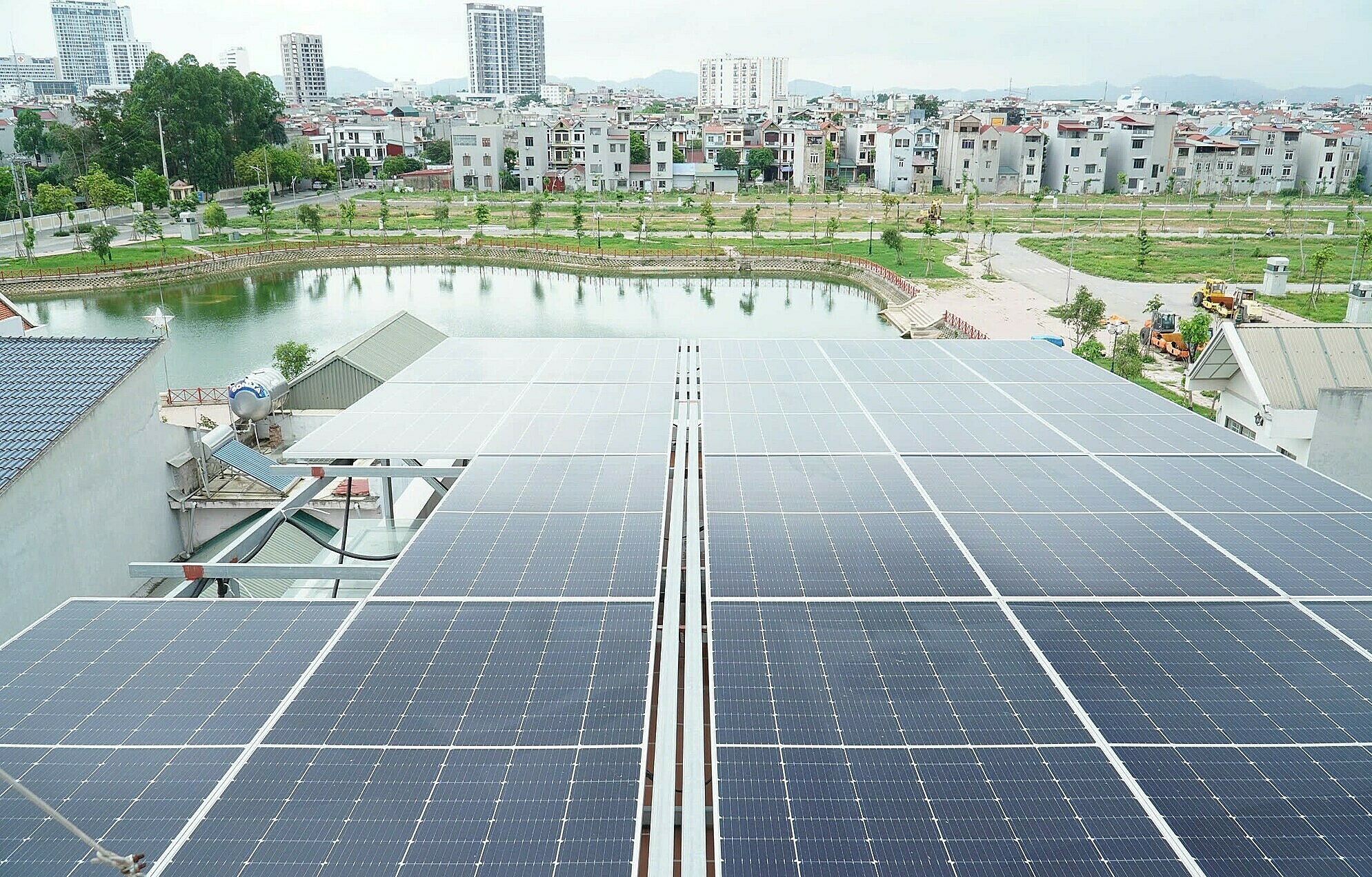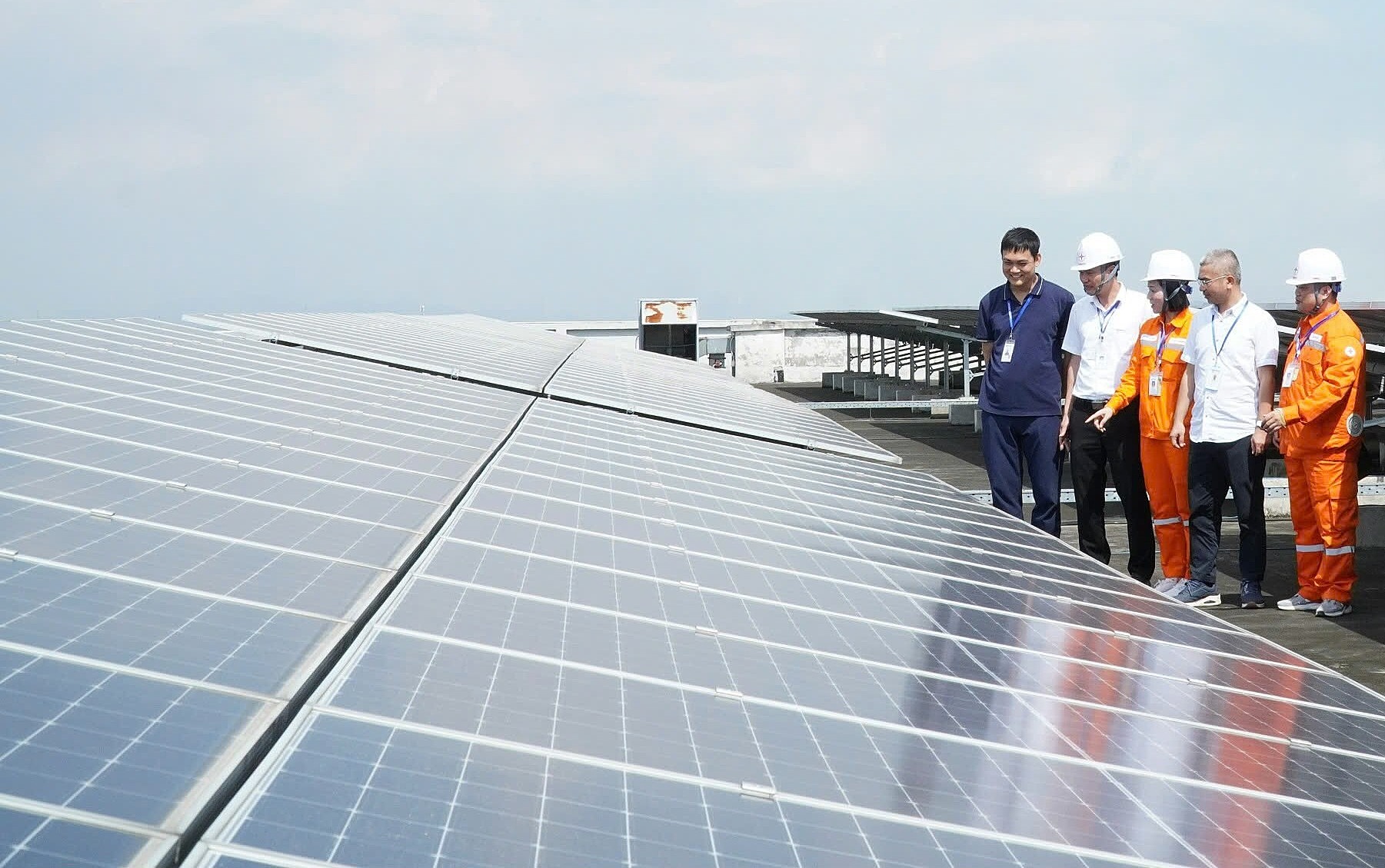Tran Thu Thuy, residing on Cao Ky Van Street in the former Bac Giang province, invested about 200 million VND in an 18 kWp rooftop solar power system with a 16.1 kWh battery energy storage system (BESS). The solar panels cover her entire 100+ square meter roof.
She explained that the system helps reduce costs and ensures a consistent power supply for her household, which includes young children and frequent use of air conditioning and an elevator.
"Our monthly bill is now only about 600,000-800,000 VND, compared to 5-6 million VND previously," she said.
 |
Tran Thu Thuy's rooftop solar power system (Bac Giang). Photo: Phuong Anh |
Tran Thu Thuy's rooftop solar power system (Bac Giang). Photo: Phuong Anh
The former Bac Giang province (now merged with Bac Ninh) has experienced rapid industrial and urban development. Implementing this model in industrial zones also helps reduce costs and ensure power for production.
For instance, Crystal Martin (Vietnam) Co., Ltd. installed a rooftop solar power system with a capacity of over 3 MW, meeting approximately 19.5% of the factory's electricity needs. They plan to invest an additional 1.2 MW next year and another 1.2 MW in 2028. By 2030, the total capacity is expected to reach 5.4 MW, allowing the factory to generate up to 30% of its electricity consumption.
Oun Kaowsiri, general director of Crystal Martin Vietnam, predicts Vietnam's electricity demand will continue to rise with industrial development and population growth. Therefore, he believes businesses need to improve energy efficiency.
"Crystal Martin aims to reduce CO2 emissions by 35% by 2030 and achieve carbon neutrality by 2050. This is a crucial goal," he said. According to Kaowsiri, since 2019, they have been installing rooftop solar power systems as one of their main solutions to reach this objective.
To date, the company has completed phase three of the project, saving approximately 3 million kWh of electricity annually. In the next 3-4 years, total solar energy production is projected to reach 6 million kWh per year, equivalent to about 40% of the factory's consumption. This will reduce operating costs and bring them closer to their net-zero emissions target.
 |
Rooftop solar power system installed at Crystal Martin (Vietnam) Co., Ltd. Photo: Phuong Anh |
Rooftop solar power system installed at Crystal Martin (Vietnam) Co., Ltd. Photo: Phuong Anh
Data from Northern Power Corporation (EVNNPC) shows that nearly 700 MWp of rooftop solar power is currently operational in northern Vietnam. Several localities like Yen Bai and Thanh Hoa have achieved positive results. Specifically, Thanh Hoa has over 600 customers with a total installed capacity of nearly 66 MWp. Yen Bai also recorded 73 stable systems, generating about 300,000 kWh for the grid.
According to Pham Dang An, deputy general director of Vu Phong Energy Group and director of VP Carbon, a solar power project developer, installing self-consumption rooftop solar systems helps save on electricity costs, significantly reducing monthly bills for households and businesses.
He believes this solution is particularly important for factories requiring stable power. It contributes to environmental protection and enhances brand reputation through carbon emission reductions, fulfilling ESG commitments, and meeting international standards. Additionally, the system increases asset value through reduced operating costs and sustainability.
From a macroeconomic perspective, An says the development of distributed renewable energy systems reduces pressure on transmission lines and minimizes power loss. Rooftop solar also promotes green transformation and economic development through job creation, supporting green industries, and enhancing export competitiveness.
"I believe rooftop solar power will be a crucial pillar in Vietnam's energy transition and sustainable development in the coming decade," he said.
This year, Vietnam aims for economic growth of 8% or higher, and double-digit growth during 2026-2030, requiring a 1.5-fold increase in electricity, projected to grow by 12-16% annually.
In northern Vietnam alone, electricity growth is forecast at 9.8-12.5%. However, anticipated earlier and more extreme heat waves, coupled with difficulties in mobilizing resources, pose challenges. This puts the northern power system at risk of local overload during peak hours, especially on hot days from May to August. To ensure supply, local power companies are encouraging and facilitating rooftop solar installations for self-consumption.
According to the adjusted Power Development Plan VIII, by 2030, the goal is to have 50% of office buildings and 50% of households using self-consumption rooftop solar power to meet on-site needs, without selling to the national grid.
To optimize effectiveness, the deputy general director of Vu Phong Energy advises households and businesses to prioritize high-efficiency and sustainable technologies. For example, panel types like Mono-PERC, Half-cut cell, or newer technologies like n-type TOPCon are suitable choices, especially for limited roof space or aesthetic requirements.
For medium-sized rooftop solar systems, string inverters are a common solution. For businesses with large installation areas, they can combine power optimizers to effectively control each panel cluster.
Additionally, An recommends installing smart monitoring systems to track performance, detect faults, and optimize operation. Integrating a battery energy storage system (BESS) using Lithium (LFP) batteries increases self-consumption and power stability, but has a higher initial cost.
Regarding financing, besides self-investment, businesses can opt for models where specialized companies invest, build, operate, and maintain the entire system. In this model, businesses only pay to lease the rooftop solar system without upfront capital investment.
Phuong Dung












